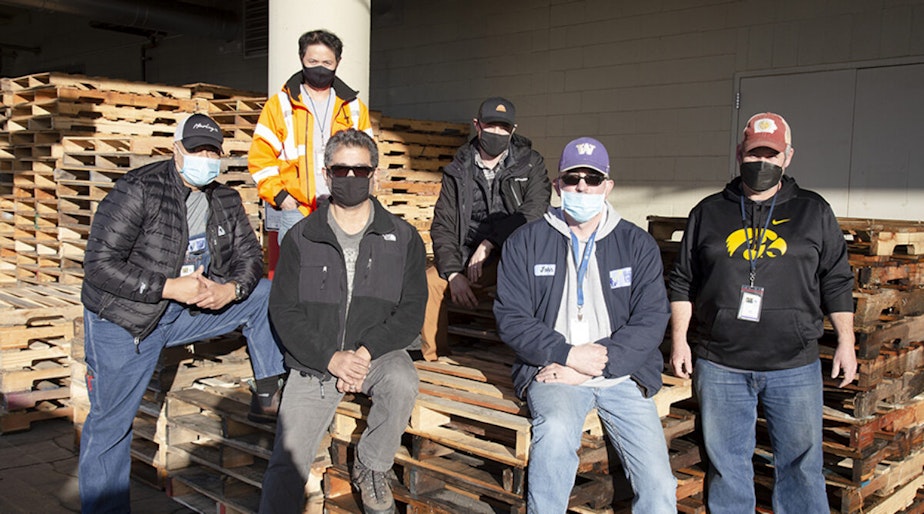Seattle Schools warehouse workers drove hours through snow for 60,000 Covid test kits

The day after the snowstorm, which was two days after Christmas, Seattle Schools officials learned that 60,000 antigen Covid test kits could be theirs. It was like winning the lottery at a time when the tests were desperately needed and in short supply.
The district urgently wanted these tests, but there was a catch: They would have to drive nearly three hours one-way after a snowstorm, on icy roads, in a two-wheel-drive box truck to a warehouse in the small town of Kalama, Washington. That’s where the Washington State Department of Health kept the Covid tests.
Gary Deitz, warehouse manager for Seattle Public Schools, knew that Superintendent Brent Jones wanted to test students and staff on the Monday they returned from winter break. Shipping the tests wasn't an option, Deitz said, “so we made the decision to go pick up the tests ourselves.”
Jones wanted these tests because the omicron variant was spiking, and few could get tested over the holidays in Seattle. Test kits were sold out at stores, and many of the in-person testing clinics were closed due to snow. Results were also taking days to process, rather than the usual 24 hours.
Closing the district as a precaution couldn’t happen; Gov. Jay Inslee had decreed that Washington state schools must stay open, with exceptions for staffing shortages or when quarantines are needed. Jones pivoted, making Monday a testing day. Those who tested positive would quarantine for 10 days.
Sponsored
It was 28 degrees that morning in the warehouse, when Gary Deitz asked for volunteers to drive to Kalama. Two warehouse workers passed, but John Franz and Mardo Liwanag agreed to it. The five inches of snow on the ground didn't deter them, nor did warnings to avoid the highways.
“The way I looked at it, this is important, we need to get kids tested to maybe help stop the spread a little bit,” Franz said.
They loaded the GMC box truck with a pallet of copy paper and five-gallon buckets of salt and sand to weigh down the back wheels, to prevent them from sliding. They threw in chains, just in case.
They left at 7 a.m. that Wednesday, and the highway was mostly clear. “Come off the freeway, there's packed snow and ice on the side roads,” Franz said. “But there was enough bare spots, bare patches.”
They drove over the freeway overpass, through what appeared to be a deserted warehouse park. They checked the address and pulled into a parking lot of slush and ice.
Sponsored
“We gave the warehouse manager a call, we had his phone number, and said, hey, we’re here from the school district, here to pick up some pallets,” Franz said. “He was pleased see us because he was by himself.” The man said he was from Hoquiam and the only person who had shown up for work.
They loaded the truck and drove back to Seattle, where warehouse workers divvied up the kits on their days off, and delivered them to 117 school sites. For older buildings, they had to go to district headquarters, and pester security for keys. Newer buildings could be accessed by badge. All told, it took them two days to get the tests in place.
Testing was in high demand that weekend and Monday, although some parents worried about being exposed to Covid during the hours-long waits inside some of the school buildings where testing was taking place. Those who didn’t wait in crowded hallways stood outside in near freezing temperatures.
Seattle Schools tested roughly 14,000 students and staff over two days, with 4% testing positive, which came as a surprise given the nearly 50% positivity rates at some PCR testing sites in south Seattle. (There’s some question about how effectively antigen tests detect Omicron, compared to PCR tests.)
Franz said he’s proud of the role curbing the spread among students and staff, driving six hours on icy roads, although insists he was just doing his job. “When I saw the news, I was like, ‘Yeah, I did that. I went down and got them,’” he said.
Sponsored
Franz has had mixed feelings about the pandemic. “It’s been a pain in the ass, to be perfectly honest,” he said. The inconsistent messaging has frustrated him, he said.
He is a man of some contradiction himself when it comes to ending the pandemic. While he got the test kits with a sense of mission, he resisted getting the coronavirus vaccine. He said his family opposes the vaccine, and several have gotten Covid, and have been fine.
“I didn’t have the Covid morbidities, or any of the other real risk factors,” he said. In other words, he probably wouldn’t die if he caught the virus.
Ultimately, he got the shot because work required it.
“I had to make that decision: Do I want to get a swab stuck up my nose every week to test?” he said. “Or do I just get the shot and go on with my life?”
Sponsored
Franz waited until he could get the Johnson & Johnson shot, because he didn’t want two jabs. He said he won’t get the booster unless required.
“I wasn't really thrilled about having to get the injection in the first place,” Franz said. “If I don't have to do get a second one, then I'm not going to.”
For him, it’s about the job, and doing it right. He makes other important deliveries too, like being part of the team that delivers 20,000 meals to students.
“This is my job,” he said. “It's what I do.”




